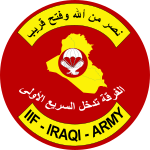1st Division (Iraq)
| 1st Division | |
|---|---|
 Official division logo | |
| Active | 1941–2003 2005–present |
| Country | |
| Branch | Iraqi Army |
| Type | Motorised Infantry |
| Size | Division |
| Part of | |
| Garrison/HQ | Camp Fallujah |
| Engagements | Anglo-Iraqi War |
| Insignia | |
| 1st Brigade SSI |  |
| Division Flag |  |

The 1st Division is a formation of the Iraqi Army.
History
Originally the 1st Division was one of the four initial divisions of the Iraqi Army, active by 1941. It later became the 1st Mechanised Division, and fought in the Iran–Iraq War, including Operation Fath ol-Mobin, in which the division suffered heavy losses, and at the Second Battle of Al Faw. It was in Kuwait during the Persian Gulf War, fought during the Battle of Khafji, and was active during the 1990s. At the beginning of the 2003 invasion of Iraq it was part of the 5th Corps in the Mosul area. It was disbanded with the rest of the Iraqi Army in May 2003.
The division was reformed c. 2005–07 after the 2003 invasion of Iraq. The 1st Division was originally formed from the battalions of the Iraqi Intervention Force.
"Prime Minister Ayad Allawi of Iraq's interim government announced organizational changes for the country's security forces, along with a plan for taking on Iraq's enemies, at a 20 June 2004 Baghdad news conference. Allawi envisions the Iraqi rapid intervention forces thwarting sabotage elements, "especially those who chose to hide behind innocent Iraqis in our cities and villages." As a first order by Iraq's new Ministry of Defense, the all-Iraqi Intervention Forces began patrolling the streets of Baghdad on 28 June 2004."[1]
Two battalions of the IIF conducted operations in Najaf between September and December 2004. Those same two battalions plus another IIF battalion, together with other Iraqi units, were present during the Second Battle of Fallujah soon afterwards.[2] The first significant troop increase for the IIF in 2005 was the graduation of 670 soldiers from the Taji military training base (Camp Taji?) on January 18, 2005.[3] The State Department claimed the IIF had 9,159 men assigned as of the Iraq Weekly Status Report for January 12, 2005.[4]
According to Major Gary Schreckengost, a MiTT from the 1st Division's 4th Brigade, 2005–06: "The 1st Brigade (original IIF) was considered the 'elite' of the Iraqi Army and as such, was deployed around the country much like a fire brigade. From 2005–06, most of its battalions were deployed in and around Ramadi or out on the Syrian border. The 3rd brigade was posted at Habbaniya and the 2nd and 4th brigades were posted in or around Fallujah. The 4th Brigade was a motorized brigade and mostly held the area east of Fallujah out to Abu Gharib."
The division was transferred to the Iraqi Ground Forces Command on February 15, 2007. The February 2007 release said the Division was headquartered in Habbaniyah, Al Anbar and operates from Baghdad to Ramadi.[5] All four brigades of the division were operational when the division was transferred to the IGFC's control. In 2008 a brigade of the division took part in the Battle of Basra (2008), which was officially designated 'Operation Charge of the Knights.' As of September 2008, the division was commanded by Brigadier General Adel Abbas.[6]

The division now acts as part of the Quick Intervention Corps, the Iraqi Army's strategic reserve. As such, as of January 2010, they currently have brigades in Mosul and north Diyala.
In June 2014, the group Islamic State of Iraq and Syria (ISIS) attacked parts of northern Iraq. In the process, it was reported that two brigades of the 1st Division were lost during the ISIS attack. Mitchell Prothero of the McClatchy Foreign Staff reported July 14, 2014 that "the 1st Division also is basically gone, losing two brigades in Anbar province earlier in the year, then two more during last month's Islamic State onslaught, including one brigade that in the words of the senior Iraqi politician was "decimated" in Diyala province northeast of Baghdad."[7]
Composition
As of January 2010 the division's dispositions appear to be:[8]
- HQ Camp Fallujah
- 1st Motorized (AAslt) Brigade – HQ (Brigade Special Troops Battalion), Camp Ali, Ramadi. One battalion at Lake Tharthar
- 2nd Motorized Brigade – currently battalions at Taji, Fallujah, and Hylateen (Diyala)
- 3rd Motorized Brigade – Previously temporarily assigned to 5th Division in Diyala, now relocated to Mosul
- 4th Motorized Brigade – Diyala. Partnered with 34th Peshmerga Bde and U.S. 1st Squadron, 14th Cavalry Regiment since April 2009.
- 1st Field Engineer Regiment – Habbenayah (former RAF Habbaniya(?))
- 1st Transportation and Provisioning Regiment – Habbenayah (former RAF Habbaniya(?))
Notes
- ^ [1], accessed 10 February 2010
- ^ Anthony Cordesman and Patrick Baetjer, Iraqi Security Forces: A Strategy for Success, Praeger Security International, Westport, Conn., 2006, p.135
- ^ Cordesman and Baetjer, 2006, p.140
- ^ Cordesman and Baetjer, p.141-142
- ^ MNF-I, Press Release: Iraqi Government and 1st Iraqi Army Division assumes control, 16 February 2007
- ^ Iraqi troops not ready to go it alone, Los Angeles Times, September 1, 2008
- ^ 1st Division, Iraqi Army. Globalsecurity.org. Retrieved May 25, 2015.
- ^ See D.J. Elliott, Iraq Order of Battle for a constantly updated Iraqi Army Order of Battle
Further reading
- West, Owen. The Snake Eaters: Counterinsurgency Advisors in Combat. Simon and Schuster, 2012 – documents the experiences of two teams of advisors to 3/3-1 Bn IA from 2005–2007 in Habbaniyah and Khalidiya
External links
- Globalsecurity.org, 1st Mechanised Division
- LongWarJournal, [2]
